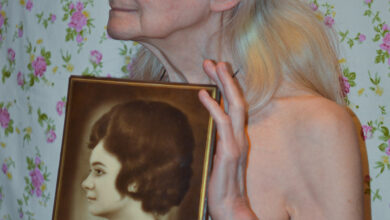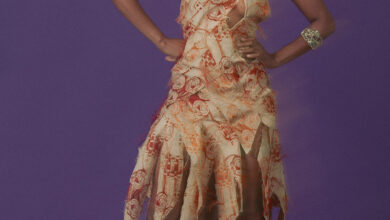FashionZoot meets
GABRIELE COLANGELO: REINTERPRETING RICHTER, REINVENTING GENNY
Italian designer Gabriele Colangelo talks to Zoot Magazine about his collection, relaunching the historical brand Genny and why Italian fashion can still make it…
Text by Anna Battista
 Clothes are always a metamorphosis: they change our bodies every day, unconsciously transforming and altering also our personality. Italian designer Gabriele Colangelo moved from an artistic metamorphosis for his Spring/Summer 2012 collection: inspired by Gerhard Richter’s over-painted photographs, he investigated the possibilities that the dichotomies between reality and abstraction, two themes at the core of Richter’s art, could offer him. Yet, rather than turning into a cold exercise into arty fashion, Colangelo’s designs became perfect examples of how an artistic inspiration can lead to interesting experiments in fabric design.
Clothes are always a metamorphosis: they change our bodies every day, unconsciously transforming and altering also our personality. Italian designer Gabriele Colangelo moved from an artistic metamorphosis for his Spring/Summer 2012 collection: inspired by Gerhard Richter’s over-painted photographs, he investigated the possibilities that the dichotomies between reality and abstraction, two themes at the core of Richter’s art, could offer him. Yet, rather than turning into a cold exercise into arty fashion, Colangelo’s designs became perfect examples of how an artistic inspiration can lead to interesting experiments in fabric design.
The designer printed images of sunsets on special jacquards partially made with print-resistant yarns; nylon threads contributed to give a shiny, iridescent quality to surfaces, silicone formed a lace-like web or gave the effect of a scraped wall on trapezoid dresses while panels of fabric on tops, dresses and skirts, referencing abstract elements, created movement. Solid colours such as inky blue and optical white edged in neon yellow prevailed though intervals of powdery pink added a soft edge to the collection.
Colangelo also designed the Spring/Summer 2012 collection for historical Italian brand Genny, launched in the ‘60s by Arnaldo Girombelli and designed between the ’70s and the ’90s by Gianni Versace. The young designer moved in this case from Peter Beard’s trips to Africa, relaunching a muted chic and sophisticated mood in silk, linen, hemp and crêpe-de-chine designs in caramel, royal blue and honey nuances decorated at times with thin astrakhan fur and characterised by asymmetrical cuts and by an understated elegance.

Zoot Magazine: Can you tell us more about the inspirations behind your Spring/Summer 2012 collection?
Gabriele Colangelo: The main inspiration came from Gerhard Richter and in particular from his over-painted photographs, that is classic images portraying scenes of ordinary life or landscapes that he alters by painting over them, adding an abstract layer. In this way Richter creates two levels: the reality of the actual photograph that caught a moment and froze it in history and time, and the abstract dream, that is the transfiguration of that reality into something more beautiful and ethereal.
Z: How did you translate these inspirations into your designs?
GC: I tried to transfer these different aspects onto my collection through an in-depth textile research, I consider this as the very first phase of my creation. This is also the phase in which I experiment the most since it’s the fabric that actually inspires me the forms and silhouettes for my collections.
“I wanted to have prints that looked like photographs…”
In the Spring/Summer collection there is an image of the sun that could be interpreted as a dawn or a sunset, so a picture of a landscape similar to Richter’s more classic images. Imitating Richter’s technique and his pictorial flows, I tried to alter the prints in the collection via a special and quite complicated process. I got jacquards that incorporated in some places a yarn that can’t be printed, so, once you print an image on them, you get the effect of a corroded photograph. As you can imagine this was a lengthy process and in some cases we worked for four months on one jacquard.
“Then I also experimented with two other themes borrowed from Richter: light and movement.”
The former was reinterpreted on the surfaces using a blend of silk and nylon fibres, since the nylon thread catches the light and reflects it in a special way. Movement was recreated instead through the oversized trapezoid shapes supported by a nylon crinoline that helped giving a waving shape to the garments.
Z: You also designed the Spring/Summer 2012 collection for Genny, a very popular Italian brand that represented for decades the main strengths of “made in Italy” products, which are great quality and design and the highest functionality. How do you feel about collaborating to relaunch such a historical brand?
GC: I’m sentimentally bound to Genny because I remember going as a child with my mother to the local boutique where she would buy Genny designs. That said, I have an almost philological approach to fashion and the fact that I’m contributing to recover the DNA of a historical Italian brand and I’m translating it in a modern key is very important for me.

Z: Did you find it difficult to recover the Genny identity?
GC: We have to take into consideration the fact that this was for more than two decades a very popular brand, but that it became a sort of “sleeping beauty” for ten years. When it was time to “re-awaken” the brand it proved difficult because we had to work on photographic and video archives as there are no actual garments in the Genny archives. At the same time, I was also very lucky because the Product Manager at my label worked for Genny for twenty years, so she acted as the historical memory in this project, while I represented the innovation.

Z: Which are the main themes behind Genny’s S/S 2012 collection?
GC: The collection was inspired by Peter Beard’s journeys to Africa and by a wild atmosphere and mood. The real challenge stood in taking animal prints and in turning them from tacky into chic, sophisticated and elegant motifs. So we got a zebra print motif from a rug I had at home, that also represented my personal tradition since I come from a family of furriers, and we printed a digitalised image of it on silk, crêpe de Chine, cotton canvases and super flat astrakhan, while employing in most of the collection traditional “Genny shades” such as caramel and honey. I would call this collection or mood “Urban Tribal” because it mixes exotic elements with urban styles.

Z: Which are the main differences between the collection for your own fashion house and the one for Genny?
GC: My own line is based on experimental techniques while the Genny collection respects the tradition of a brand with a wider distribution. Yet both the Colangelo and the Genny collections are based on textile reseach and “made in Italy” quality.
Z: Do you feel that the fashion industry in the last few years focused more on quantity rather than on quality?
GC: You see, quality is the result of a solid know-how. We do have an amazing know-how in Italy, but quality has a price. In the last few years quality has lost to quantity and lower prices and we have seen a very different culture prevailing, a culture that prompts people to consume everything faster and faster, without caring about how long a product lasts as long as it has got a great visual impact. Yet this is not part of the Italian tradition and this is exactly what makes the difference. We always talk about educating consumers and we must seriously start doing it now.
Z: Do you think that Italy’s long-standing textile tradition, damaged by the global crisis and by cheaper competition from other countries, may somehow be restored also thanks to young designers like you?
GC: Yes I do. I’m actually very lucky since I collaborate with companies that are making a financial investment on my collections and are creating particular studies and special textiles for myself, that they will be able to use also in their future collections, so I see this as a strong exchange between Italian traditions and new ideas.
Z: In your opinion, can Italians still “do it better”?
GC: Well, a lot of American, British and French designers are still produced in Italy and Italy has got strong traditions in tailoring, textiles and ready-to-wear in general that should be appreciated a bit better. Instead quite a few people think that these traditions are “old” and this is really the wrong attitude to things.
“I think we should learn from other countries how to appreciate and support what we have.”
In the States, when Anna Wintour decides that young people should be helped she is supported by an entire apparatus. In Italy we do have Franca Sozzani who is doing her best at Vogue Italia to help up-and-coming designers, but we do have fewer and fewer companies ready to invest on young people. Some may do so for two seasons, but then they abandon them as soon as they don’t get an immediate financial reward.
 Z: What do you dislike about contemporary fashion?
Z: What do you dislike about contemporary fashion?
GC: Contemporary fashion is based on superficial communication.You see, my designs are based on construction and on details that on the runway often get lost because they do have a limited visual impact. It’s easier to overdo things by covering a dress in layers and layers of ruffles or in thousands of sequins, but it’s much more difficult to strip things down and get to the real core of a design.
Z: Which are the most important qualities a fashion designer should have and who are your favourite designers?
GC: Sacrifice, dedication and a method, because I do not see creativity as something separate from a method. There are a few brands that have my modus operandi and my passion for researching, among them Jil Sander, Prada and Marni. I particularly like the fact that a brand such as Prada carries out artistic experiments but then applies them to wearable garments. I also like Celine’s minimalism and Lanvin’s elegant lines. I guess I like fashion houses that produce feminine yet functional pieces as I do feel that we, as fashion designers, have one very important aim, and that’s dressing women who must feel beautiful in our creations. A garment should indeed highlight a woman’s beauty and not obliterate her.











